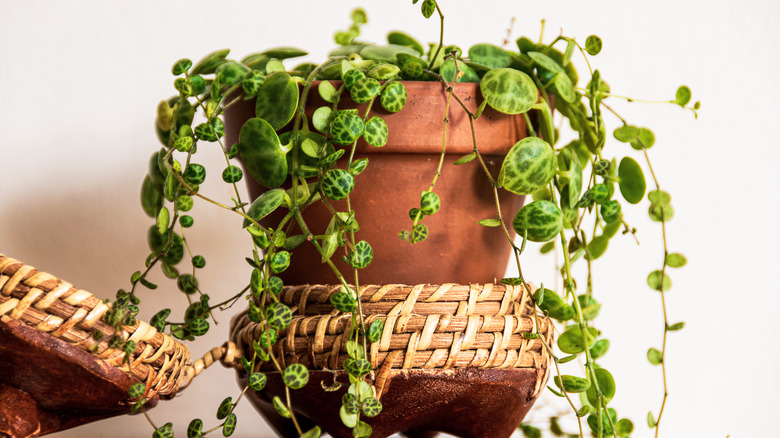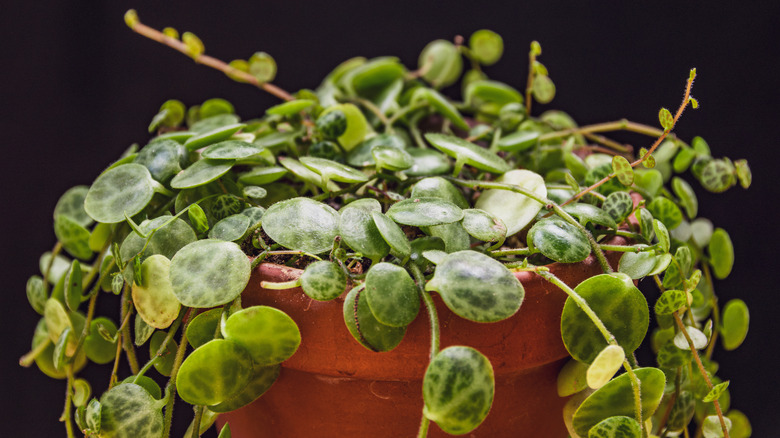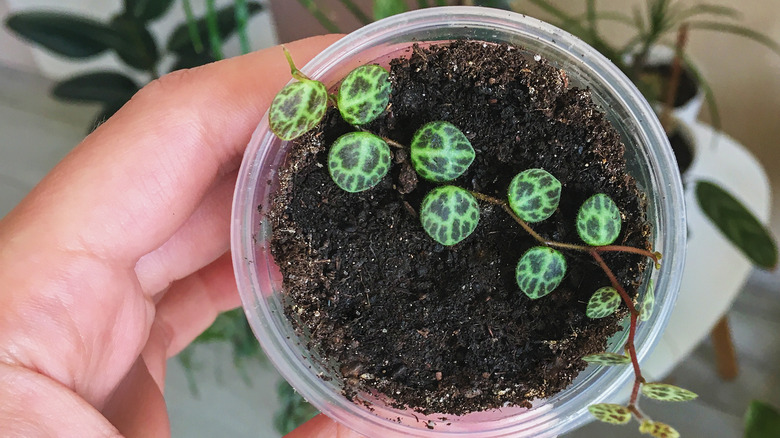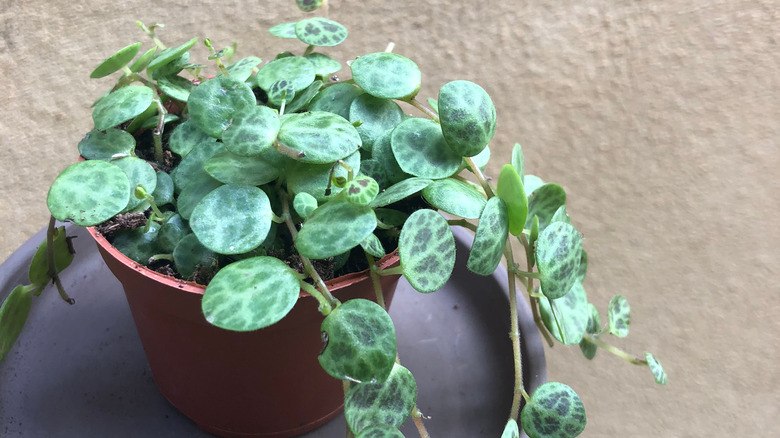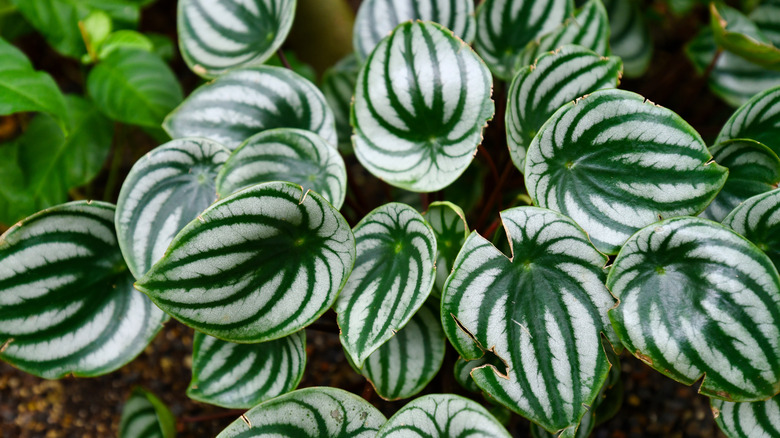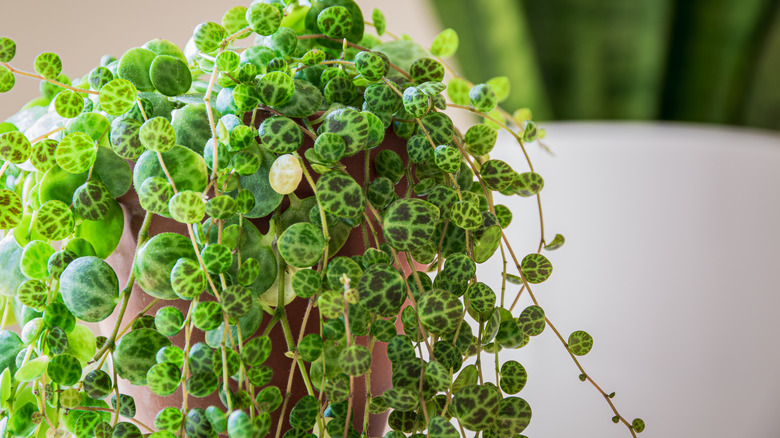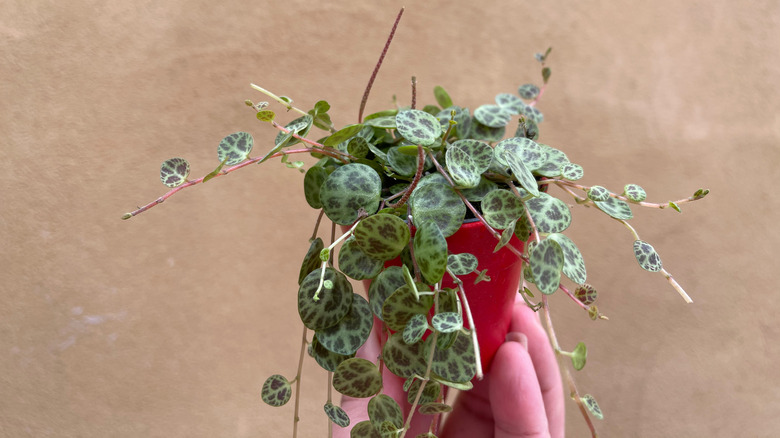String Of Turtles: Everything You Should Know Before Planting
String of turtles, also known by its scientific name Peperomia prostrata, is a succulent aptly named due to the appearance of its leaves. This plant has trailing stems that are lined with circular green leaves decorated with a lighter green pattern that give them the appearance of a turtle shell. The leaves grow to a maximum of 2 inches in diameter, although it is common to find 1 inch leaves as well, as per Gardening Brain. The size of the entire plant varies based on the container in which it is planted and/or the space in which it has to grow. Over the course of a few years, the string of turtles plant can sprawl out to 2 feet in width.
While most string of turtles typically only display leaves, some grow small, white flowers during warmer times of the year. This slow-growing plant is easy to grow and maintain both indoors and outdoors, depending on the region of the world where it is planted, but is most popular as a houseplant.
This animal-themed plant is tropical in nature, originating in the rainforests of South America, according to Terrarium Tribe. Although the string of turtles is often found growing off other plants or trees in the wild, it can easily be adapted to gardens and homes around the world with the right growing conditions. Keep scrolling for an in-depth look of this plant and how to care for it.
How to use string of turtles in garden
String of turtles is rarely found growing in a garden bed, but can easily be planted in a container and placed in a garden or patio to brighten up your space with its vibrant green leaves. Remember that the tropical origins of this plant make it incredibly picky when it comes to temperature. If you're considering placing it outdoors, do so during a season when temperatures stay around 65 to 75 degrees Fahrenheit, per Planterina. The best part of planting the string of turtles in a container is that you can easily transport it indoors when temperatures rise or fall outside of these parameters.
If you're wondering where in your garden to put your string of turtles, you have a few options. Firstly, string of turtles prefer indirect light, but will not thrive in too much shade. The light that reaches your plant should be filtered yet bright. Many people enjoy hanging their string of turtle plants to allow the trailing vines to cascade over the sides and create a waterfall appearance. A partially shaded porch or balcony works well for this. Another option is to place your string of turtles in a standing pot that can be placed next to a garden bed or along a path to draw the eye. This plant also looks cute next to a backyard pond — just remember to leave it in a pot and not plant it in the wet soil around the water.
How to grow string of turtles
To get started planting your string of turtles, you'll need a pot or container that will adequately fit the size of your plant, a high-quality potting soil with good draining properties, and a basic houseplant fertilizer. It's important to note that string of turtles need a container with drainage holes to ensure that the soil doesn't get too soggy, according to Gardening Brain. To plant your string of turtles in the container, fill it 2/3 of the way with soil and then place your string of turtles on top, making sure the roots will be completely covered when you fill in the rest of the container with soil. Give it some water after it is situated in its new home.
If you'd like to propagate your string of turtles once it's planted and growing, there are a few easy ways to do so. According to Sprouts and Stems, the most effective and popular way to propagate your string of turtles is to take a cutting and place it in potting soil. You'll want to first cut off a stem of your string of turtles where it emerges from the main stem. Bury the end that was closest to the main stem in the potting soil and give it a sprinkle of water, then let it sit in an indirectly sunny spot. You'll know the cutting has taken root when you slowly pull up on it a couple weeks later and it displays some resistance.
How to care for string of turtles
With the right conditions, you'll have a happy string of turtles on your hands. The most important factors in the well-being of your string of turtles are soil, light, humidity, and water. The string of turtles makes for the perfect houseplant because of its low light needs, says Two Peas in a Condo. Direct light should be avoided at all costs to avoid causing harm to your plant. While string of turtles can be placed anywhere inside your home, avoid placing it next to windows that receive direct light at any time of the day. If you've already planted your string of turtles in a high-quality, well-draining soil, you're on the right track to providing the adequate growing environment for your plant. All you'll need to do from here on out is keep your string of turtles regularly watered, but never to the point of complete soil saturation. The top soil should be dry before you give it more water.
Although the string of turtles doesn't love overly soggy soil, they do love moist, humid environments and will thrive in drier months with a bit of daily misting. If you live in a particularly cold and dry environment, consider leaving a humidifier running to keep your string of turtles moist year-round. In the spring and summer, add a bit of mild houseplant fertilizer to your string of turtles' soil to encourage healthy growth and color. Make sure to water the soil before fertilizing.
Varieties of string of turtles
This plant is native to South America and often goes by other names, including chain of turtles, jade necklace, and turtle vine. The string of turtles is part of the Peperomia genus, which includes over 1,500 unique species, according to Leafy Place. The species differ greatly from one another, with some boasting small, rounded succulent-type leaves similar to those of the string of turtles, and others featuring large, pointed leaves. According to Southern Living, all Peperomia plants are referred to colloquially as radiator plants due to their love of warm environmental conditions.
Some of the most common varieties of Peperomia, including the American baby rubber plant, are characterized by oval leaves similar in appearance to those of the string of turtles, but slightly larger. This variety is also absent of the trailing vines of leaves characteristic of string of turtle plants. Another species of Peperomia is the trailing jade. While this plant does feature the same sprawling stems of leaves as the string of turtles, the leaves are thick, squishy, and absent of the unique turtle-shell pattern of its cousin. The watermelon peperomia features heart-shaped leaves with the same surface pattern of the watermelon fruit. Finally, the peperomia hope has thick, oval leaves that sprout from sprawling vines and is commonly grown in hanging baskets and containers. It is a smaller variety of Peperomia and grows slowly over time.
Is string of turtles toxic?
Another great reason to purchase a string of turtles for your home and/or garden is that it is non-toxic, according to Hobby Plants. This means that if you have a curious child or pet, accidental ingestion will not land anyone in the emergency room.
Although the string of turtles can be safely ingested and touched, eating the plant is not recommended. Tearing, chewing, or ingesting the string of turtles can potentially cause fatal damage to the plant itself. One popular way to make sure no one will eat the plant is to keep it in a hanging basket or container, which automatically puts it out of reach of small children and animals. Just make sure to cut back the hanging vines if they grow too long to avoid a child grabbing at it and potentially pulling it down on top of themselves.
Tips for keeping pets, in particular, away from your houseplants, in addition to placing them out of reach, is to use a repellant spray that will dissuade your pets from getting too close, according to Martha Stewart. You can also use positive reinforcement to train them to stay away from plants. Making sure they have enough pet-approved toys to play with and chew on will also ensure they don't try to use your string of turtles as a playmate. Your best bet, however, is to never leave your pets in the same room as your houseplant when you aren't able to supervise.
How to repot string of turtles
According to Gardening Brain, the string of turtles plant does not need to be repotted frequently due to its slow growing speed. A couple signs that it needs a bigger pot include overgrowth of the vines that engulf the pot it is planted in and the plant becoming root bound, which means the roots start growing outside of the pot through the drainage holes. Lotus Magus recommends shooting for a new pot every two to three years, depending on individual plant growth rate, to keep your plant healthy and growing comfortably. In between repottings, you can replace the top soil on a yearly basis to keep it fresh.
Repotting your string of turtles is an easy and straightforward process that requires the same materials you used when you potted it in the first place. The new pot should provide enough additional room to avoid having to repot your plant too soon, but you should make sure the container isn't too roomy to avoid creating space for root-targeting pests and diseases. Before placing it in its new pot, lightly shake off the existing soil from the roots. Fill your new container with potting mix and then place your string of turtles inside, making sure the roots do not emerge over the top. Cover it with more potting soil and pack it gently. Then give it a good drink of water, only watering again once the top soil dries out.
